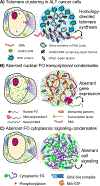Phase Separation in Biology and Disease; Current Perspectives and Open Questions
- PMID: 36690068
- PMCID: PMC9970028
- DOI: 10.1016/j.jmb.2023.167971
Phase Separation in Biology and Disease; Current Perspectives and Open Questions
Abstract
In the past almost 15 years, we witnessed the birth of a new scientific field focused on the existence, formation, biological functions, and disease associations of membraneless bodies in cells, now referred to as biomolecular condensates. Pioneering studies from several laboratories [reviewed in1-3] supported a model wherein biomolecular condensates associated with diverse biological processes form through the process of phase separation. These and other findings that followed have revolutionized our understanding of how biomolecules are organized in space and time within cells to perform myriad biological functions, including cell fate determination, signal transduction, endocytosis, regulation of gene expression and protein translation, and regulation of RNA metabolism. Further, condensates formed through aberrant phase transitions have been associated with numerous human diseases, prominently including neurodegeneration and cancer. While in some cases, rigorous evidence supports links between formation of biomolecular condensates through phase separation and biological functions, in many others such links are less robustly supported, which has led to rightful scrutiny of the generality of the roles of phase separation in biology and disease.4-7 During a week-long workshop in March 2022 at the Telluride Science Research Center (TSRC) in Telluride, Colorado, ∼25 scientists addressed key questions surrounding the biomolecular condensates field. Herein, we present insights gained through these discussions, addressing topics including, roles of condensates in diverse biological processes and systems, and normal and disease cell states, their applications to synthetic biology, and the potential for therapeutically targeting biomolecular condensates.
Keywords: biomolecular condensates; membraneless organelles; phase separation.
Copyright © 2023 The Authors. Published by Elsevier Ltd.. All rights reserved.
Conflict of interest statement
Declaration of Competing Interest The authors declare the following financial interests/personal relationships which may be considered as potential competing interests: D.M.M. is an employee and shareholder of Dewpoint Therapeutics; B.P. is an employee and shareholder of Dewpoint Therapeutics; J.F.R. is an an officer and shareholder of Nereid Therapeutics; J.S. is a consultant for Dewpoint Therapeutics, ADRx, and Neumora, and a shareholder and advisor for Confluence Therapeutics; L.C.S. is on the Prose Foods Scientific Advisory Board; M.W. was an employee and shareholder of Faze Medicines when this article was conceived and initially written, and currently is an employee of IDEXX Laboratories; R.K. reports personal fees from Dewpoint Therapeutics, GLG Consulting, and New Equilibrium Biosciences outside the submitted work.
Figures





Similar articles
-
Sequence variations of phase-separating proteins and resources for studying biomolecular condensates.Acta Biochim Biophys Sin (Shanghai). 2023 Jul 18;55(7):1119-1132. doi: 10.3724/abbs.2023131. Acta Biochim Biophys Sin (Shanghai). 2023. PMID: 37464880 Free PMC article. Review.
-
Splicing regulation through biomolecular condensates and membraneless organelles.Nat Rev Mol Cell Biol. 2024 Sep;25(9):683-700. doi: 10.1038/s41580-024-00739-7. Epub 2024 May 21. Nat Rev Mol Cell Biol. 2024. PMID: 38773325 Free PMC article. Review.
-
Phase separation in biology and disease-a symposium report.Ann N Y Acad Sci. 2019 Sep;1452(1):3-11. doi: 10.1111/nyas.14126. Epub 2019 Jun 14. Ann N Y Acad Sci. 2019. PMID: 31199001 Free PMC article.
-
Sodium ion influx regulates liquidity of biomolecular condensates in hyperosmotic stress response.Cell Rep. 2023 Apr 25;42(4):112315. doi: 10.1016/j.celrep.2023.112315. Epub 2023 Apr 4. Cell Rep. 2023. PMID: 37019112
-
Biomolecular condensates: A new lens on cancer biology.Biochim Biophys Acta Rev Cancer. 2025 Feb;1880(1):189245. doi: 10.1016/j.bbcan.2024.189245. Epub 2024 Dec 13. Biochim Biophys Acta Rev Cancer. 2025. PMID: 39675392 Review.
Cited by
-
Liquid-liquid phase separation in diseases.MedComm (2020). 2024 Jul 13;5(7):e640. doi: 10.1002/mco2.640. eCollection 2024 Jul. MedComm (2020). 2024. PMID: 39006762 Free PMC article. Review.
-
Disorder-mediated interactions target proteins to specific condensates.Mol Cell. 2024 Sep 19;84(18):3497-3512.e9. doi: 10.1016/j.molcel.2024.08.017. Epub 2024 Sep 3. Mol Cell. 2024. PMID: 39232584
-
Dynamic RNA synthetic biology: new principles, practices and potential.RNA Biol. 2023 Jan;20(1):817-829. doi: 10.1080/15476286.2023.2269508. Epub 2023 Dec 3. RNA Biol. 2023. PMID: 38044595 Free PMC article. Review.
-
A New Phase for WNK Kinase Signaling Complexes as Biomolecular Condensates.Physiology (Bethesda). 2024 Sep 1;39(5):0. doi: 10.1152/physiol.00013.2024. Epub 2024 Apr 16. Physiology (Bethesda). 2024. PMID: 38624245 Review.
-
Coacervates Composed of Low-Molecular-Weight Compounds- Molecular Design, Stimuli Responsiveness, Confined Reaction.Adv Biol (Weinh). 2025 May;9(5):e2400572. doi: 10.1002/adbi.202400572. Epub 2025 Feb 12. Adv Biol (Weinh). 2025. PMID: 39936890 Free PMC article. Review.
References
-
- Shin Y, Brangwynne CP. Liquid phase condensation in cell physiology and disease. Science. 2017;357. - PubMed
-
- Ferrie JJ, Karr JP, Tjian R, Darzacq X. “Structure”-function relationships in eukaryotic transcription factors: The role of intrinsically disordered regions in gene regulation. Mol Cell. 2022;82:3970–84. - PubMed
Publication types
MeSH terms
Grants and funding
- R35 GM139531/GM/NIGMS NIH HHS/United States
- R35 NS111604/NS/NINDS NIH HHS/United States
- R21 AG079609/AG/NIA NIH HHS/United States
- R01 GM138690/GM/NIGMS NIH HHS/United States
- U54 CA243124/CA/NCI NIH HHS/United States
- R37 CA240765/CA/NCI NIH HHS/United States
- R01 NS127186/NS/NINDS NIH HHS/United States
- P30 CA021765/CA/NCI NIH HHS/United States
- R01 GM099836/GM/NIGMS NIH HHS/United States
- DP2 GM149752/GM/NIGMS NIH HHS/United States
- R01 GM147583/GM/NIGMS NIH HHS/United States
- R01 CA246125/CA/NCI NIH HHS/United States
- U01 CA260851/CA/NCI NIH HHS/United States
- R21 AG065854/AG/NIA NIH HHS/United States
- R01 GM132447/GM/NIGMS NIH HHS/United States
- R35 GM131891/GM/NIGMS NIH HHS/United States
- R35 GM136338/GM/NIGMS NIH HHS/United States
LinkOut - more resources
Full Text Sources
Miscellaneous

